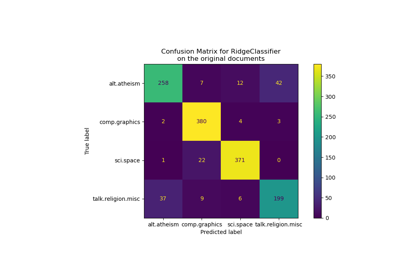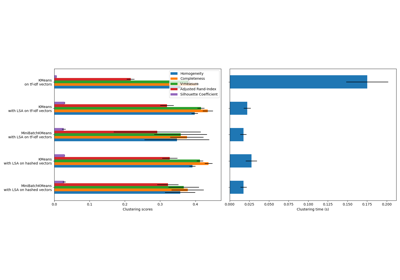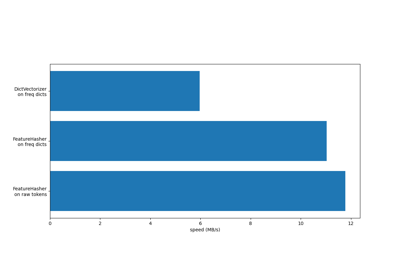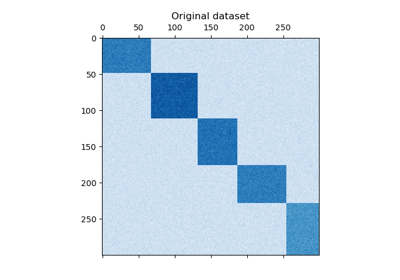Note
Go to the end to download the full example code or to run this example in your browser via JupyterLite or Binder.
Biclustering documents with the Spectral Co-clustering algorithm#
This example demonstrates the Spectral Co-clustering algorithm on the twenty newsgroups dataset. The ‘comp.os.ms-windows.misc’ category is excluded because it contains many posts containing nothing but data.
The TF-IDF vectorized posts form a word frequency matrix, which is then biclustered using Dhillon’s Spectral Co-Clustering algorithm. The resulting document-word biclusters indicate subsets words used more often in those subsets documents.
For a few of the best biclusters, its most common document categories and its ten most important words get printed. The best biclusters are determined by their normalized cut. The best words are determined by comparing their sums inside and outside the bicluster.
For comparison, the documents are also clustered using MiniBatchKMeans. The document clusters derived from the biclusters achieve a better V-measure than clusters found by MiniBatchKMeans.
Vectorizing...
Coclustering...
Done in 1.56s. V-measure: 0.4415
MiniBatchKMeans...
Done in 2.90s. V-measure: 0.3015
Best biclusters:
----------------
bicluster 0 : 8 documents, 6 words
categories : 100% talk.politics.mideast
words : cosmo, angmar, alfalfa, alphalpha, proline, benson
bicluster 1 : 1948 documents, 4325 words
categories : 23% talk.politics.guns, 18% talk.politics.misc, 17% sci.med
words : gun, guns, geb, banks, gordon, clinton, pitt, cdt, surrender, veal
bicluster 2 : 1259 documents, 3534 words
categories : 27% soc.religion.christian, 25% talk.politics.mideast, 25% alt.atheism
words : god, jesus, christians, kent, sin, objective, belief, christ, faith, moral
bicluster 3 : 775 documents, 1623 words
categories : 30% comp.windows.x, 25% comp.sys.ibm.pc.hardware, 20% comp.graphics
words : scsi, nada, ide, vga, esdi, isa, kth, s3, vlb, bmug
bicluster 4 : 2180 documents, 2802 words
categories : 18% comp.sys.mac.hardware, 16% sci.electronics, 16% comp.sys.ibm.pc.hardware
words : voltage, shipping, circuit, receiver, processing, scope, mpce, analog, kolstad, umass
# Authors: The scikit-learn developers
# SPDX-License-Identifier: BSD-3-Clause
from collections import Counter
from time import time
import numpy as np
from sklearn.cluster import MiniBatchKMeans, SpectralCoclustering
from sklearn.datasets import fetch_20newsgroups
from sklearn.feature_extraction.text import TfidfVectorizer
from sklearn.metrics.cluster import v_measure_score
def number_normalizer(tokens):
"""Map all numeric tokens to a placeholder.
For many applications, tokens that begin with a number are not directly
useful, but the fact that such a token exists can be relevant. By applying
this form of dimensionality reduction, some methods may perform better.
"""
return ("#NUMBER" if token[0].isdigit() else token for token in tokens)
class NumberNormalizingVectorizer(TfidfVectorizer):
def build_tokenizer(self):
tokenize = super().build_tokenizer()
return lambda doc: list(number_normalizer(tokenize(doc)))
# exclude 'comp.os.ms-windows.misc'
categories = [
"alt.atheism",
"comp.graphics",
"comp.sys.ibm.pc.hardware",
"comp.sys.mac.hardware",
"comp.windows.x",
"misc.forsale",
"rec.autos",
"rec.motorcycles",
"rec.sport.baseball",
"rec.sport.hockey",
"sci.crypt",
"sci.electronics",
"sci.med",
"sci.space",
"soc.religion.christian",
"talk.politics.guns",
"talk.politics.mideast",
"talk.politics.misc",
"talk.religion.misc",
]
newsgroups = fetch_20newsgroups(categories=categories)
y_true = newsgroups.target
vectorizer = NumberNormalizingVectorizer(stop_words="english", min_df=5)
cocluster = SpectralCoclustering(
n_clusters=len(categories), svd_method="arpack", random_state=0
)
kmeans = MiniBatchKMeans(
n_clusters=len(categories), batch_size=20000, random_state=0, n_init=3
)
print("Vectorizing...")
X = vectorizer.fit_transform(newsgroups.data)
print("Coclustering...")
start_time = time()
cocluster.fit(X)
y_cocluster = cocluster.row_labels_
print(
f"Done in {time() - start_time:.2f}s. V-measure: \
{v_measure_score(y_cocluster, y_true):.4f}"
)
print("MiniBatchKMeans...")
start_time = time()
y_kmeans = kmeans.fit_predict(X)
print(
f"Done in {time() - start_time:.2f}s. V-measure: \
{v_measure_score(y_kmeans, y_true):.4f}"
)
feature_names = vectorizer.get_feature_names_out()
document_names = list(newsgroups.target_names[i] for i in newsgroups.target)
def bicluster_ncut(i):
rows, cols = cocluster.get_indices(i)
if not (np.any(rows) and np.any(cols)):
import sys
return sys.float_info.max
row_complement = np.nonzero(np.logical_not(cocluster.rows_[i]))[0]
col_complement = np.nonzero(np.logical_not(cocluster.columns_[i]))[0]
# Note: the following is identical to X[rows[:, np.newaxis],
# cols].sum() but much faster in scipy <= 0.16
weight = X[rows][:, cols].sum()
cut = X[row_complement][:, cols].sum() + X[rows][:, col_complement].sum()
return cut / weight
bicluster_ncuts = list(bicluster_ncut(i) for i in range(len(newsgroups.target_names)))
best_idx = np.argsort(bicluster_ncuts)[:5]
print()
print("Best biclusters:")
print("----------------")
for idx, cluster in enumerate(best_idx):
n_rows, n_cols = cocluster.get_shape(cluster)
cluster_docs, cluster_words = cocluster.get_indices(cluster)
if not len(cluster_docs) or not len(cluster_words):
continue
# categories
counter = Counter(document_names[doc] for doc in cluster_docs)
cat_string = ", ".join(
f"{(c / n_rows * 100):.0f}% {name}" for name, c in counter.most_common(3)
)
# words
out_of_cluster_docs = cocluster.row_labels_ != cluster
out_of_cluster_docs = out_of_cluster_docs.nonzero()[0]
word_col = X[:, cluster_words]
word_scores = np.array(
word_col[cluster_docs, :].sum(axis=0)
- word_col[out_of_cluster_docs, :].sum(axis=0)
)
word_scores = word_scores.ravel()
important_words = list(
feature_names[cluster_words[i]] for i in word_scores.argsort()[:-11:-1]
)
print(f"bicluster {idx} : {n_rows} documents, {n_cols} words")
print(f"categories : {cat_string}")
print(f"words : {', '.join(important_words)}\n")
Total running time of the script: (0 minutes 7.734 seconds)
Related examples

Classification of text documents using sparse features


